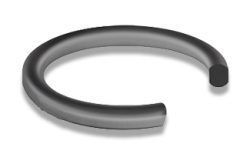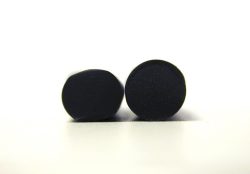Compression Set
What is a compression set?
In a nutshell, the compression set of a material is the permanent deformation remaining after the removal of a force that was applied to it. ‘Set’ is a term that is used to characterise something that had been deformed by a force and when released does not fully return to its original shape, it has ‘set’ in this position. Compression Set is the most common O Ring / Gasket failure. An efficient O Ring seal needs a continuous ‘seal line’ between the sealed surfaces which is a function of gland design and seal cross-section. In order to keep the seal integrity without undue deformation of the seal, the ‘seal line’ establishes the correct amount of compression on the O Ring.
What is compression set testing?
Compression Set testing measures the ability of an elastomer to restore its original shape and thickness following the extensive compressive force at a certain temperature and deflection. When an elastomer material is compressed, after some time it loses its ability to restore its original shape. The loss of memory (flexibility) will consequently decrease the capability of a seal to perform. The consequent lasting set that the seal may take over time can cause leaks where the force within the material is not pushing against the flange face anymore. It then requires constant bolt torque monitoring and tightening, which will additionally jeopardize the performance of the elastomer. Undue use of low-grade fillers is the main cause for greater compression set properties with the additional issue of a substantial decrease in media resistance.
The results
The results of a compression set test are expressed as a percentage maximum figure – the lower the percentage figure, the better the material resists constant deformation under given environments. To clarify, a low value indicates that the tested elastomer possesses the ability to maintain its sealing properties and will more likely be effective in given working circumstances for a prolonged duration. A satisfactory and excellent compression test result is anything of 20% and under meaning a good functional sealing capacity. Many high-grade sheeting materials perform between 20-25% compression set and most good quality commercial grade sheeting materials between 25-35% compression set. However, any material with a compression set of 40% and above should be avoided as there is a high likelihood that it will fail and are a risk to both the plant and personnel.
What are the visual indications?
O Ring becomes less circular and has flattened surfaces (takes shape of a flat-sided oval), has taken the shape of the groove, and is unable to return to its original shape.

Contributing Factors
- Physical and chemical changes appear.
- Chemical attack increases cross-link density, consequently the seal loses its elasticity and ability to permanently return back to its shape.
- Excessive temperature, which causes the seal to lose its flexibility.
- Volume swell due to system fluid.
- Excessive compression and/or over-tightening.
- Seal losing its flexibility due to cross-link density increase.
- Improper gland/groove design.
- Poor compression set properties of a selected material.
- Fluid incompatible with the seal material.
- Elastomer with high compression set.
- Incomplete curing of an elastomer material during production.
Prevention and Solutions
- Choose seal material that resists both operating and friction generated heat.
- Select elastomer materials with a low compression set.
- Verify material compatibility with intended application environments.
- Use more elastic polymer structure.
- Check gland design.
- Confirm the seal is not over-squeezed.
- Reduce excessive frictional heat build-up at the seal interface.
- Lower system operating temperature.
How is the compression set measured?
- The height of an O Ring is measured prior to testing.
- O Ring is placed in jig under pressure, then placed in the oven.
- The jig is dismantled and O Ring removed.
- O Ring recovers for 30 minutes, and the height is measured.
- Cooling of the O Ring and the jig can produce a substantial ‘cold set.’
The compression set is usually measured in the laboratory without any applied pressure, at a constant temperature. Such specified and unvaried environments make it difficult to apply to the real world. Therefore, it is frequently necessary for the trends to develop and carry out testing over a range of times and temperatures.
What is a ‘cold set’?
A measured compression set has two constituents:
- Development of new crosslinks, within the polymer chains in the compressed position. consequently, it prevents the seal to restore its original shape when the force is removed and results in a permanent, non-reversible effect.
- Chain movements possible at elevated temperatures cannot relax at lower temperatures, this is due to the system force not being adequately high. Reactions as such are not permanent and will relax out when the temperature rises. This is often referred to as a ‘cold set’.
Why is compression set important?
In the thermal and pressure cycling systems, the decrease in cross-section leads to lower contact sealing force, which consequently raises the risk of leakage. Creating an effective seal requires a reaction force between the hardware and the elastomer aka ‘sealing force’. The compression set gives insight into this reaction force and decrease in sealing efficiency over time.
What is Compressive Stress Relaxation (CSR)?
A compressed elastomer will generate a ‘sealing force’ as mentioned above. After a period of time, the generated ‘sealing force’ will decrease – this is known as Compressive Stress Relaxation (CSR). Following the exposure to high temperatures or chemicals (which attack the polymer backbone or cross-linking system), CSR can be accelerated. CSR is measured by compressing a standard test item to a constant force and measuring the strain exerted by the test item at particular intervals under predetermined conditions. The decaying stress is expressed as a percentage of the initial counterforce.
To find out more about other O Ring failure modes, see our O Ring Failure Guide.
If you require further information regarding our range of products and/or services, please contact a member of the team.
E & OE. M Barnwell Services endeavour to make sure that all content is correct. The information has been gathered from manufacturing partners.
